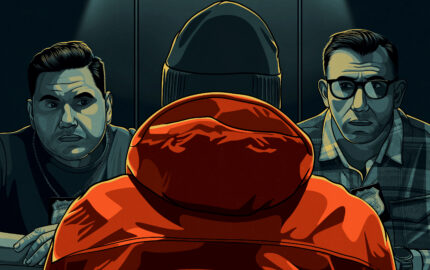We call lots of things “stories” in American journalism, but very few of them are true narrative storytelling. Most journalistic accounts are reports, whose primary purpose is to pass along information to readers. Reports require certain writing strategies to help readers figure things out: the telling quote, the revealing statistic, the deep explanation, a piece of jargon translated for the general reader. Readers use the information in their roles as citizens, consumers, residents and parents.
Stories render experience. When we embed elements of narrative into our reports, we don’t just point readers to a place, we use language to put them there, to allow them to inhabit it. Narrative can be used in news reports, in commentary, even in editorials.
Gene Patterson was editor of The Atlanta Constitution from 1960 to 1968. Every single day for nine years, he wrote a column that appeared in his newspaper. Every single day. I read all 3,200 columns – an exercise that transported me back in time. This body of work is one of the most important epics in the history of American journalism, even in this country’s history.
On Sept. 16, 1963, he published a column called, “A Flower for the Graves.” It is argument, but it also has a story. It starts with a scene, a moment in time:
He introduces a detail that immediately becomes a symbol: a child’s shoe:
In these first four sentences, Gene Patterson took his audience of white Southerners from whatever emotional, political, geographic place they resided, and transported them to 16th Street in Birmingham. In the middle of the piece, he returns to the shoe:
At the end of the column, he returns to narrative:
After that column appeared, Walter Cronkite called Gene Patterson and asked if he would read the entire column on the CBS Evening News. Can you imagine that happening today?
When we write stories, rather than reports, Who becomes character. What becomes action set in time. Where becomes setting. When becomes chronology, or time unraveled. Why becomes motive. How becomes narrative – how things happened. All these changes happen, and the role of the narrator becomes much more important.
The narrator can play a number of roles in the story. One strategy is simply to provide a slice of life, to tell a story that has no obvious moral. Here is another example by Gene Patterson, from a 1960 column called “When the Wind Rises, a Mind Changes:”
Through editorials like this, Gene established himself as a person of that place, of the South, sharing a common humanity with other Southerners.
A second strategy, which I call the subordinate narrator, lets the source tell the story. Journalists usually do this with quotes, but it can also be done with narration. A third strategy is parallel narrative – when the narrator tells two seemingly separate stories that collide at the end. The next example, an editorial published Oct. 8, 1962, uses both narrative strategies. The occasion is the attempted desegregation of the University of Mississippi. The piece begins like this:
He tells the story of Biles’ role in World War II, and connects it to his work protecting James Meredith:
Later in the piece, Gene moves into subordinate narration:
Patterson would win a Pulitzer Prize for his columns about civil rights. He helped change his region and the nation, not only because of his legendary moral and physical courage, but also because he understood the power of the story to persuade.
Adapted from the presentation at the 2002 Nieman Conference on Narrative Journalism, “The Narrative of Persuasion.” Edited by Mark Kramer and Wendy Call.
Stories render experience. When we embed elements of narrative into our reports, we don’t just point readers to a place, we use language to put them there, to allow them to inhabit it. Narrative can be used in news reports, in commentary, even in editorials.
Gene Patterson was editor of The Atlanta Constitution from 1960 to 1968. Every single day for nine years, he wrote a column that appeared in his newspaper. Every single day. I read all 3,200 columns – an exercise that transported me back in time. This body of work is one of the most important epics in the history of American journalism, even in this country’s history.
On Sept. 16, 1963, he published a column called, “A Flower for the Graves.” It is argument, but it also has a story. It starts with a scene, a moment in time:
A Negro mother wept in the street Sunday morning in front of a Baptist Church in Birmingham. In her hand she held a shoe, one shoe, from the foot of her dead child.
He introduces a detail that immediately becomes a symbol: a child’s shoe:
We hold that shoe with her. Every one of us in the white South holds that small shoe in his hand.
In these first four sentences, Gene Patterson took his audience of white Southerners from whatever emotional, political, geographic place they resided, and transported them to 16th Street in Birmingham. In the middle of the piece, he returns to the shoe:
We hold that shoe in our hand, Southerner. Let us see it straight, and look at the blood on it. Let us compare it with the unworthy speeches of Southern public men who have traduced the Negro; match it with the spectacle of shrilling children whose parents and teachers turned them free to spit epithets at small huddles of Negro school children for a week before this Sunday in Birmingham; hold up the shoe and look beyond it to the state house in Montgomery where the official attitudes of Alabama have been spoken in heat and anger.
At the end of the column, he returns to narrative:
The Sunday school play at Birmingham is ended. With a weeping Negro mother, we stand in the bitter smoke and hold a shoe. If our South is ever to be what we wish it to be, we will plant a flower of nobler resolve for the South now upon these four small graves that we dug.
After that column appeared, Walter Cronkite called Gene Patterson and asked if he would read the entire column on the CBS Evening News. Can you imagine that happening today?
When we write stories, rather than reports, Who becomes character. What becomes action set in time. Where becomes setting. When becomes chronology, or time unraveled. Why becomes motive. How becomes narrative – how things happened. All these changes happen, and the role of the narrator becomes much more important.
The narrator can play a number of roles in the story. One strategy is simply to provide a slice of life, to tell a story that has no obvious moral. Here is another example by Gene Patterson, from a 1960 column called “When the Wind Rises, a Mind Changes:”
A week ago, a little wind storm ruffled middle Georgia. It is widely forgotten now, but it left a mark on the mind. The car radio had mentioned tornado conditions, but my mind was on the general problems that ride with a man on a trip. Between Cochsran and Eastman, the wind grew and the problems dwindled. It was just a little blow. But for a while it took my attention. A curtain of dust moved across the earth. Headlights were needed in places to drive. Clouds as gray as the dust moved low. Grit got in the teeth. The wind combed the knee-high corn nearly flat in the fields, and turned up the whites of leaves.
Through editorials like this, Gene established himself as a person of that place, of the South, sharing a common humanity with other Southerners.
A second strategy, which I call the subordinate narrator, lets the source tell the story. Journalists usually do this with quotes, but it can also be done with narration. A third strategy is parallel narrative – when the narrator tells two seemingly separate stories that collide at the end. The next example, an editorial published Oct. 8, 1962, uses both narrative strategies. The occasion is the attempted desegregation of the University of Mississippi. The piece begins like this:
I wish the students at the University of Mississippi knew Herbert W. Biles of Atlanta. He is 45. He is a correctional officer at the Atlanta Federal Penitentiary. I first knew him when he was 28. He came to my platoon of the 10th Armored Division as a replacement during combat in Germany.
He tells the story of Biles’ role in World War II, and connects it to his work protecting James Meredith:
On Sunday night, a week ago, the same great Southerner stood shoulder to shoulder on the Ole Miss campus with his brother Robert, also an Atlantan and also a penal correctional officer. Both had been ordered deputies as U.S. marshals, and they did their duty to the flag they serve. Their country had commanded them to guard the life of James Meredith. But federal troops had not come, Mississippi police had withdrawn, and the thin line of marshals faced a terrible mob of rioters with tear gas running out. Bricks and bottles struck them, but they stood.
Later in the piece, Gene moves into subordinate narration:
They stood and held until the paratroopers came – “the prettiest sight in the world,” Herbert recalls. By then, he was one of the 166 marshals who had been hurt. But they held.
Robert Biles was one of five marshals who went to Washington and received personal citations for bravery from the President. “If you had failed and they had taken Mr. Meredith,” the President said, “It would have been a blow from which the United States and Mississippi would not have recovered for many years.”
Herbert Biles, back in Atlanta, was philosophical. “It was worse than anything we saw in the war,” he said, without bitterness. “During the war, you could shoot back. That was the last we wanted to do out there, and the students could do anything. Their screaming and hollering is what got me. I’ve never cursed like that in my life.
“Being born and bred in Georgia, I might have felt out of place there if I had thought of it as something I was doing only for Meredith. But the way I looked at it, I thought I was doing more for those Mississippi students than I was for Meredith. I felt that by standing there, that I was saving them from themselves.”
Patterson would win a Pulitzer Prize for his columns about civil rights. He helped change his region and the nation, not only because of his legendary moral and physical courage, but also because he understood the power of the story to persuade.
Adapted from the presentation at the 2002 Nieman Conference on Narrative Journalism, “The Narrative of Persuasion.” Edited by Mark Kramer and Wendy Call.


